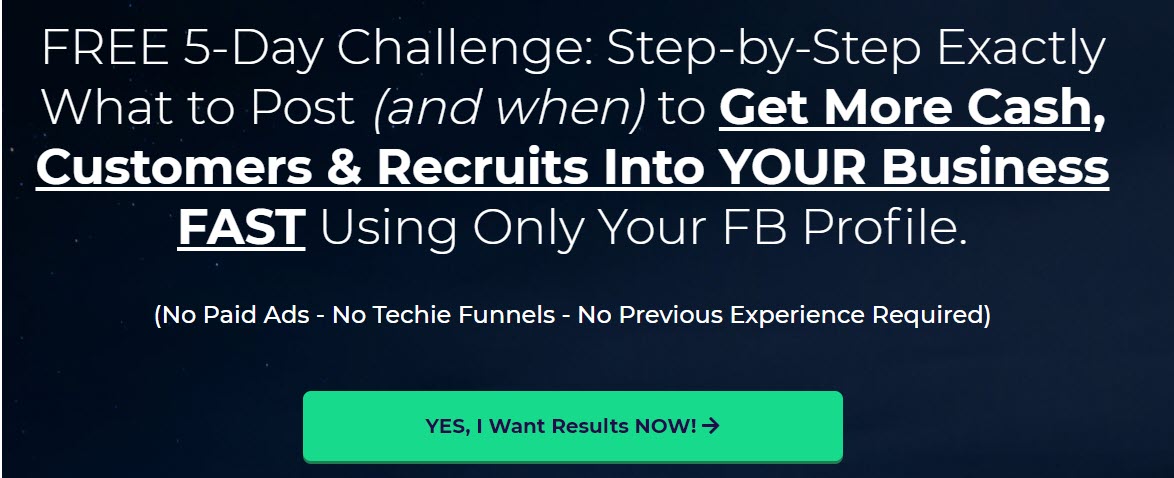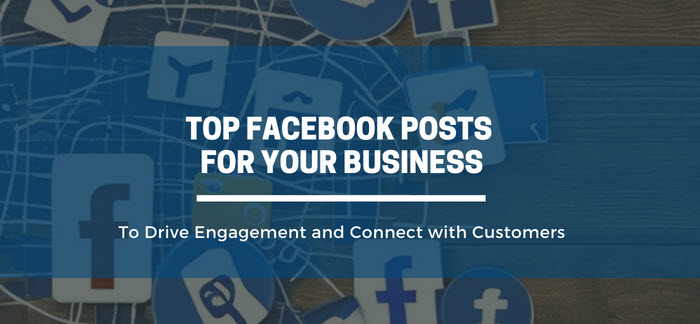


Batching Your Social Media Content: How to Streamline Your Strategy and Save Time
Social media has become an integral part of modern-day marketing. With the power to reach millions of potential customers in just a few clicks, social media has changed the way businesses interact with their audience. However, keeping up with a consistent social media schedule can be time-consuming and exhausting. That’s where “batching” your social media content comes in. In this article, we’ll explore what batching is, why it’s important, and how you can streamline your social media strategy to save time and energy.
What is Content Batching?
Batching is the process of creating and scheduling multiple social media posts in one sitting, rather than creating them individually as you go. By batching your content, you can streamline your social media strategy and save time by reducing the amount of time spent on content creation and scheduling.
Why is Content Batching Important?
Batching your social media content has several benefits, including:
1. Saving Time
Creating social media content can be a time-consuming process, especially if you’re doing it on a daily basis. Batching your content allows you to create multiple posts in one sitting, freeing up time for other tasks.
2. Consistency
Consistency is key when it comes to social media. Batching your content ensures that you have a consistent posting schedule, which can help increase engagement and build your brand.
3. Increased Efficiency
When you’re creating and scheduling social media posts individually, it’s easy to get sidetracked by other tasks. Batching your content allows you to focus on content creation and scheduling in one sitting, which can increase efficiency and productivity.
How to Batch Your Social Media Content
Batching your social media content is easier than you might think. Here are the steps you can follow to streamline your strategy and save time:
1. Create a Content Calendar
A content calendar is a schedule of all the social media posts you plan to create and publish. Creating a content calendar allows you to plan ahead and ensure that you have a consistent posting schedule.
2. Brainstorm Content Ideas
Before you start creating your social media posts, take some time to brainstorm content ideas. This can include topics related to your industry, promotions you’re running, or current events.
3. Create Your Content
Once you have your content ideas, it’s time to start creating your social media posts. This can include writing captions, creating graphics, or shooting photos or videos.
4. Schedule Your Posts
Once you’ve created your social media posts, it’s time to schedule them. Use a scheduling tool like Content Studio, or Buffer to schedule your posts in advance.
5. Monitor and Engage
Even after your social media posts are scheduled, it’s important to monitor and engage with your audience. This can include responding to comments or messages, liking and sharing other users’ posts, or running social media campaigns.
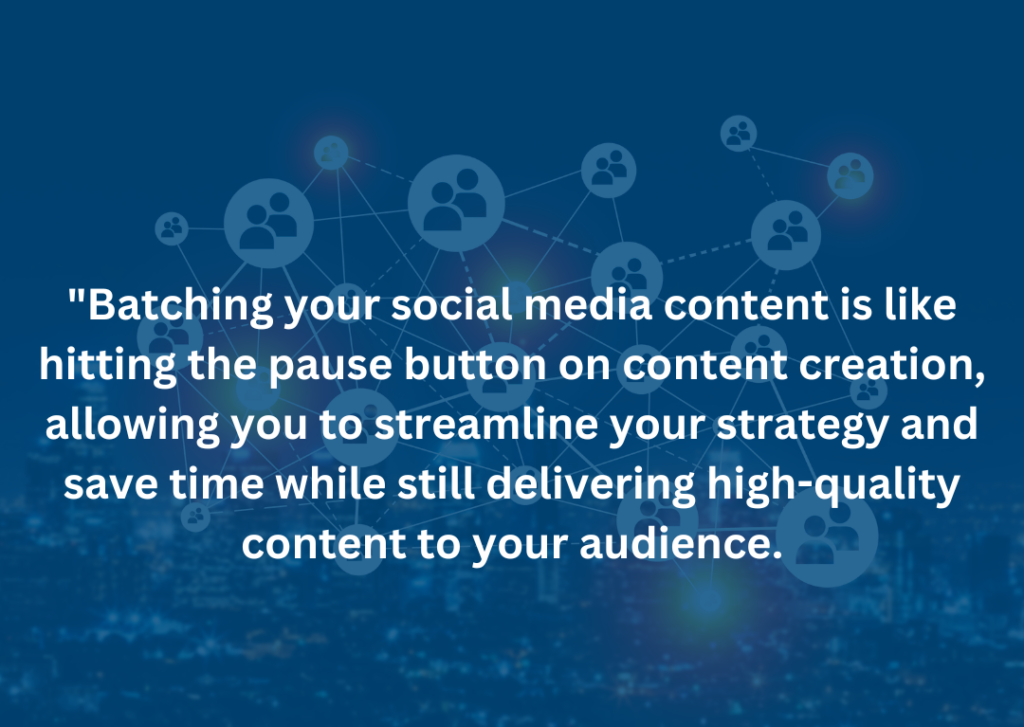
Best Practices for Batching Your Social Media Content
To get the most out of your batching strategy, it’s important to follow these best practices:
1. Keep Your Brand Voice Consistent
Maintaining a consistent brand voice across all your social media platforms is key to building a strong brand. Make sure to keep your tone, language, and messaging consistent across all your posts.
2. Use a Variety of Content Types
Don’t just rely on text-based posts. Incorporate graphics, photos, videos, and other types of content to keep your social media feeds interesting and engaging.
3. Engage with Your Audience
Social media is all about engagement. Make sure to respond to comments, messages, and other user-generated content to build relationships with your audience.
4. Analyze Your Results
To ensure that your batching strategy is working effectively, it’s important to regularly analyze your results. Use social media analytics tools to track your engagement, reach, and other metrics, and adjust your strategy as needed.
5. Stay Up-to-Date with Social Media Trends
Social media is constantly evolving, so it’s important to stay up-to-date with the latest trends and best practices. Attend conferences, read industry blogs, and follow social media experts to stay informed and inspired.
Conclusion
Batching your social media content is a simple but effective way to streamline your strategy and save time. By creating and scheduling multiple posts in one sitting, you can ensure consistency, increase efficiency, and focus on other tasks. To get the most out of your batching strategy, make sure to keep your brand voice consistent, use a variety of content types, engage with your audience, analyze your results, and stay up-to-date with the latest trends.
FAQs
- How often should I batch my social media content?
There is no one-size-fits-all answer to this question. It depends on the size of your business, the amount of content you need to create, and other factors. Some businesses may choose to batch their content weekly, while others may batch it monthly or even quarterly.
- What tools can I use to batch my social media content?
There are several tools available for batching your social media content, including Hootsuite, Buffer, and Later. Choose a tool that works best for your business and budget.
- Can I still engage with my audience if I’m batching my social media content?
Absolutely. Even if your social media content is pre-scheduled, it’s important to monitor and engage with your audience regularly. This can include responding to comments, messages, and user-generated content.
- How can I ensure that my social media content is high-quality when batching?
To ensure that your social media content is high-quality, take the time to plan your content calendar, brainstorm ideas, and create a variety of content types. Use social media analytics tools to track your results and adjust your strategy as needed.
- Can batching my social media content save me money?
Yes. By reducing the amount of time spent on content creation and scheduling, you can free up time for other tasks, which can ultimately save you money. Additionally, some social media scheduling tools offer affordable pricing plans that can help you save money on your overall marketing strategy.
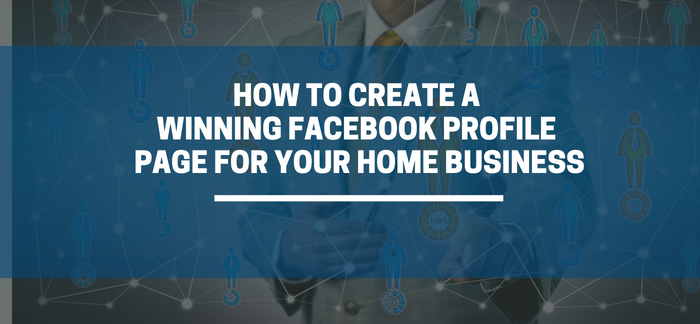
How to Create a Winning Facebook Profile Page for Your Home Business: Top Strategies
In today’s digital age, an online presence is crucial for any business, including home-based ones. Having a strong online presence can help a business grow and succeed because it lets you reach a wider audience, build a stronger brand identity, and interact with your customers. And when it comes to social media, Facebook is without a doubt one of the most popular and effective platforms for businesses. However, merely having a Facebook page is not enough. To make the most of this platform, you need to optimize your Facebook profile page. In this post, we will discuss the benefits of optimizing your Facebook profile page for your home business and provide some tips on how to do it effectively.
Understanding the Facebook profile page
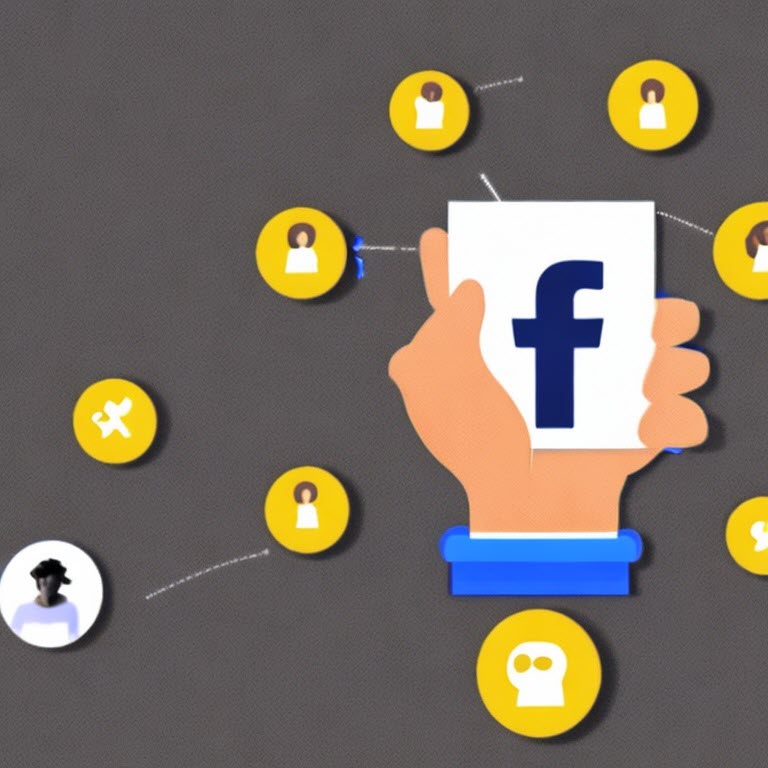
Before we dive into the benefits and tips, let’s first discuss what a Facebook profile page is and its main elements. Your Facebook profile page is essentially your digital identity on the platform. It is where you showcase your business and connect with your audience. The main elements of a Facebook profile page include the profile picture, cover photo, about section, posts, reviews, and call-to-action (CTA) buttons. Each of these elements plays a critical role in creating a professional and engaging presence on Facebook.
Benefits of Optimizing Your Facebook Profile
1. Reach a wider audience:
Optimizing your Facebook personal page can help increase your visibility and reach a wider audience. By optimizing your personal page, you increase the chances of your page being discovered by potential customers. By providing relevant and high-quality content, you are more likely to appear in search results and attract organic traffic to your page.
2. Build a strong brand identity:
Your personal page is an opportunity to showcase your brand’s personality and values. By creating a cohesive and visually appealing personal page, you establish a consistent brand identity that customers can recognize and relate to. This can help build trust and brand loyalty among your followers.
3. Connect with your audience:
A personal page can help you connect with your audience on a more personal level. By sharing content and engaging with your followers, you can build relationships and establish a loyal following of customers who trust and support your business.
4. Share relevant and engaging content:
Sharing regular updates and interesting content on your personal page can attract and engage potential customers. By providing value to your audience, you can keep them interested and engaged with your brand, which can lead to increased customer loyalty.
5. Establish credibility and trust:
By having a professional and well-optimized personal page, you establish credibility and trust with potential customers. A well-optimized personal page shows that you are serious about your business and that you care about your online presence and reputation.
6. Networking opportunities:
Your personal page can be a great way to connect with like-minded individuals and expand your network. By connecting with other business owners and influencers, you can gain valuable insights, advice, and support for your business.
7. Increased customer loyalty:
By having a strong online presence, you can establish a loyal following of customers who trust and support your business. By consistently providing value to your audience, you can build a relationship with them and establish long-term loyalty.
8. Promote your products or services:
Your personal page can be a platform to promote your products or services and attract potential customers. By sharing information about your products or services, you can generate interest and attract new customers.
9. Provide customer support:
By being active and engaging on your personal page, you can provide customer support and answer questions from potential or existing customers. This can help build trust and establish a reputation for excellent customer service.
10. Gain valuable insights:
By analyzing the data and insights provided by Facebook, you can better understand your audience’s behavior and tailor your content and marketing strategies accordingly. This can help you make data-driven decisions and optimize your personal page for maximum impact.
Tips for optimizing your Facebook profile page
Here are some tips for optimizing your Facebook profile page:
1. Choose a clear and professional profile picture:
Choosing a profile picture that is clear and professional is an important part of building a good online reputation. Whether you are creating a profile for a social media platform, a professional networking site, or any other online platform, your profile picture is often the first thing that others will notice about you. Therefore, it is important to choose a profile picture that presents you in a positive and professional light.
First and foremost, your profile picture should be clear and high quality. A blurry or pixelated image can create a negative impression and suggest that you are not taking the platform seriously. Make sure that your picture is well-lit and in focus, and that it is an appropriate size for the platform. Most platforms will have specific requirements or recommendations for profile picture dimensions, so be sure to follow these guidelines to ensure that your picture looks its best.
In addition to clarity and quality, your profile picture should also be professional in nature. This means avoiding pictures that are too casual or personal in nature, such as vacation photos, selfies, or pictures with distracting backgrounds. Instead, opt for a headshot or a photo that presents you in a professional context, such as a picture taken at a conference or during a work-related event. This will help to convey a sense of competence and professionalism, and will help others to take you seriously.
Finally, be mindful of your appearance in your profile picture. Dress appropriately and make sure that your hair, makeup, and accessories are in line with the tone and expectations of the platform. If you are unsure of what is appropriate, take a look at other users’ profile pictures to get a sense of what is common and expected.
2. Use a visually appealing cover photo:
Using a visually appealing cover photo is another important aspect of building a positive online presence. Your cover photo is the large image that appears at the top of your profile, and it provides an opportunity to showcase your personality, interests, or professional brand. Whether you are creating a profile for a social media platform, a professional networking site, or any other online platform, your cover photo can help to set the tone and create a strong visual impression.
First and foremost, your cover photo should be visually appealing and engaging. This means choosing an image that is high quality, colorful, and visually interesting. It can be a photograph, an illustration, or any other type of image that reflects your personality, interests, or brand. The image should be clear and in focus, and it should be an appropriate size and resolution for the platform.

In addition to being visually appealing, your cover photo should also be relevant to your brand or message. If you are creating a professional profile, for example, your cover photo might showcase your work or industry. If you are creating a personal profile, your cover photo might reflect your hobbies or interests. Whatever the case, make sure that your cover photo is consistent with your overall brand or message, and that it helps to communicate who you are and what you are all about.
Finally, be mindful of the tone and messaging of your cover photo. Your cover photo should be visually engaging and memorable, but it should also be appropriate for the platform and your audience. Make sure that your cover photo is in line with the values and expectations of your audience, and that it creates a positive and welcoming impression.
3. Create a compelling “About” section:
Creating a compelling “About” section on Facebook is an important aspect of building a positive online presence. Your “About” section provides an opportunity to introduce yourself, share your interests, and showcase your accomplishments. Whether you are creating a personal profile or a professional page, a well-crafted “About” section can help to engage your audience, build your brand, and create a sense of connection and community.
First and foremost, your “About” section should be well-written and engaging. It should provide a brief summary of who you are, what you do, and what you are all about. Start with a clear and concise introduction that sets the tone and establishes your brand or message. Then, elaborate on your interests, accomplishments, and goals, using descriptive language and storytelling techniques to create a compelling narrative.
In addition to being engaging, your “About” section should also be organized and easy to read. Use headings, bullet points, and other formatting techniques to break up the text and make it more visually appealing. This will help to draw the reader’s eye to key points and make your message more memorable.
4. Post regular updates:
Posting regular updates on Facebook is an important aspect of building a positive online presence. Whether you are creating a personal profile or a professional page, regular updates help to keep your audience engaged, informed, and connected. By sharing updates that are relevant, interesting, and valuable, you can build a loyal following, establish yourself as an authority in your field, and create a strong online brand.
First and foremost, your updates should be relevant to your audience. Consider who your audience is and what they are interested in, and tailor your updates accordingly. For example, if you are creating a professional page for a fitness business, your updates might focus on exercise tips, healthy eating, and motivational stories. If you are creating a personal profile for a travel enthusiast, your updates might focus on your latest adventures, interesting places you have visited, and recommendations for other travelers.
In addition to being relevant, your updates should also be interesting and valuable. Share information, insights, and stories that your audience is likely to find engaging and useful. This might include news articles, blog posts, videos, or personal anecdotes. Use your updates to spark conversations, ask questions, and invite feedback, creating a sense of community and connection with your audience.
5. Respond to comments and messages:
Responding to comments and messages is a critical aspect of building a positive online presence on Facebook. Whether you are creating a personal profile or a professional page, responding to comments and messages can help to build engagement, establish trust, and create a sense of community with your audience.
First and foremost, it’s important to respond to comments and messages in a timely manner. Aim to respond within 24 hours, or sooner if possible. This shows your audience that you are attentive and responsive, and helps to build trust and loyalty. If you receive a lot of comments or messages, consider setting up automatic responses or delegating the task to a team member.
When responding to comments and messages, it’s important to be polite, professional, and helpful. Even if you receive negative comments or criticism, it’s important to respond with a level head and a positive attitude. Avoid getting defensive or confrontational, and instead focus on addressing the issue at hand and finding a constructive solution.
In addition to being polite and professional, it’s important to be personal and authentic in your responses. Use your own voice and personality to create a connection with your audience, and avoid generic or canned responses. This will help to create a sense of community and foster loyalty among your followers.
Finally, be mindful of your tone and messaging when responding to comments and messages. Consider your audience and the platform, and adjust your tone and messaging accordingly. For example, if you are creating a personal profile for a hobby or interest, you might be more casual and playful in your responses. If you are creating a professional page, you might be more formal and focused on addressing the needs and concerns of your audience.
Optimizing your Facebook page is essential for a strong online presence and can help your business reach new customers and grow. However, there may be various reasons why people don’t optimize their Facebook page, ranging from lack of time to limited access to technology. It’s important to understand these challenges and find ways to overcome them to make the most out of your Facebook page.

Networking on Facebook to Boost Your Business
Have you ever wondered how many doors you could open, connections you could forge, and opportunities you could seize with just a few clicks? What if I told you that the key to unlocking a world of networking possibilities lies within the realm of Facebook? Yes, you read that right! The same platform where you connect with friends, share cat videos, and scroll through memes can also serve as a powerful tool for networking. So, put aside your preconceptions and get ready to dive into the captivating world of networking on Facebook.
In today’s digital age, social media platforms have become instrumental in connecting people from all walks of life. Among these platforms, Facebook stands out as a powerhouse for networking, offering countless opportunities to build relationships, expand professional connections, and foster personal growth. Whether you are an entrepreneur, a job seeker, or simply looking to connect with like-minded individuals, mastering the art of networking on Facebook can open doors to new opportunities and bring about meaningful interactions. In this article, we will explore the diverse facets of networking on Facebook, highlighting its benefits, providing tips for effective networking, and answering commonly asked questions to help you navigate this dynamic virtual landscape with confidence.
Table of Contents
- What is Networking on Facebook?
- Definition and Importance of Networking on Facebook
- Leveraging Facebook for Networking: Getting Started
- Creating a Professional Profile
- Optimizing Privacy Settings for Networking
- Building Your Network: Strategies for Success
- Joining Relevant Groups and Communities
- Engaging in Meaningful Discussions
- Connecting with Industry Experts and Influencers
- Participating in Events and Webinars
- Maximizing the Power of Facebook Pages
- Creating and Managing a Facebook Page
- Growing Your Audience and Engaging Followers
- Collaborating with Other Page Owners
- Utilizing Facebook Groups for Networking
- Understanding the Benefits of Facebook Groups
- Finding and Joining Relevant Groups
- Active Participation and Value Contribution
- Networking on Facebook: Etiquette and Best Practices
- Being Authentic and Transparent
- Cultivating Relationships with Care
- Offering Help and Support
- Maintaining Professionalism
- Tools and Features for Effective Networking on Facebook
- Messenger: Direct Communication Made Easy
- Facebook Live: Engaging with Your Audience in Real Time
- Events: Connecting and Collaborating through Virtual Gatherings
- Marketplace: Expanding Your Reach and Opportunities
- Commonly Asked Questions about Networking on Facebook
- FAQ 1: How do I search for specific individuals or businesses on Facebook?
- FAQ 2: Can I network on Facebook without revealing personal information?
- FAQ 3: What should I consider before connecting with someone on Facebook?
- FAQ 4: How can I leverage Facebook groups for networking?
- FAQ 5: What are some tips for maintaining a professional image on Facebook?
- FAQ 6: How do I balance personal and professional networking on Facebook?
- Conclusion
- Hire me on Fiverr for SEO & Content Writing Services
What is Networking on Facebook?
Networking on Facebook refers to the process of establishing and nurturing professional and personal connections on the popular social media platform. It involves actively engaging with others, sharing knowledge, and building relationships within your industry or areas of interest. Networking on Facebook allows you to tap into a vast network of individuals, including industry experts, potential clients, employers, colleagues, and like-minded individuals, enabling you to expand your reach, gain insights, and discover new opportunities.
Leveraging Facebook for Networking: Getting Started
Creating a Professional Profile: When embarking on your networking journey on Facebook, it’s crucial to present yourself professionally. Craft a compelling bio, highlight your skills and experiences, and showcase your professional achievements. Choose a high-quality profile picture that reflects your
professional demeanor. Remember to keep your profile information up-to-date, ensuring that it accurately represents your current professional status and goals.
Optimizing Privacy Settings for Networking: Facebook provides a range of privacy settings that allow you to control the visibility of your profile and posts. Take the time to review and adjust your privacy settings to strike a balance between sharing relevant information with your network and maintaining your desired level of privacy. Consider making your professional information visible to the public or to specific groups of people to enhance your networking opportunities.
Building Your Network: Strategies for Success
Joining Relevant Groups and Communities: Facebook offers a multitude of groups and communities catering to various interests, industries, and professions. Search for groups relevant to your field and join those that align with your goals and aspirations. Actively participate in discussions, share valuable insights, and engage with other group members to establish yourself as a knowledgeable and reliable resource.
Engaging in Meaningful Discussions: Networking on Facebook goes beyond collecting connections. It involves actively participating in meaningful conversations and adding value to discussions. Be proactive in sharing your expertise, asking thought-provoking questions, and offering insightful comments. By contributing meaningfully to conversations, you can establish your credibility and attract like-minded individuals to connect with you.
Connecting with Industry Experts and Influencers: Facebook provides a unique opportunity to connect directly with industry experts and influencers. Seek out individuals who inspire you or are leaders in your field. Follow their pages, engage with their content, and participate in discussions they initiate. Building relationships with influential figures can open doors to valuable connections and mentorship opportunities.
Participating in Events and Webinars: Facebook hosts a wide range of events, webinars, and live sessions facilitated by industry experts and organizations. Take advantage of these opportunities to expand your knowledge, network with participants, and engage in conversations with speakers. Actively participate by asking questions and sharing your insights during these events, as this can help you establish yourself as an active and engaged member of the community.
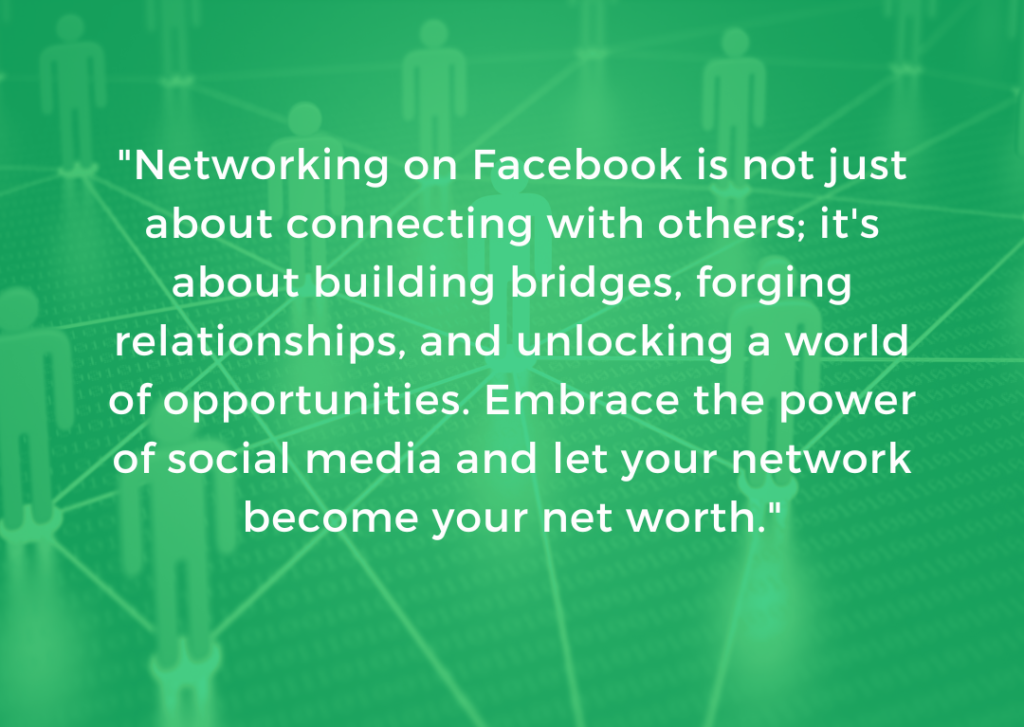
Maximizing the Power of Facebook Pages
Creating and Managing a Facebook Page: If you have a business or personal brand, creating a Facebook Page can significantly enhance your networking efforts. A Facebook Page allows you to showcase your brand, share updates, and connect with your audience on a larger scale. Customize your page with a compelling cover photo, engaging content, and relevant information to attract followers and potential networking opportunities.
Growing Your Audience and Engaging Followers: Consistently posting high-quality content and engaging with your audience is key to growing your Facebook Page. Share valuable insights, industry news, and engaging visuals to capture the attention of your followers. Respond to comments, messages, and inquiries promptly, fostering a sense of community and building rapport with your audience.
Collaborating with Other Page Owners: Building connections with other Facebook Page owners can be mutually beneficial. Look for opportunities to collaborate with complementary brands or individuals in your industry. This can include co-hosting events, cross-promoting each other’s content, or engaging in joint initiatives. Collaborations can help you tap into new networks and reach a wider audience, leading to increased networking opportunities.
Utilizing Facebook Groups for Networking
Understanding the Benefits of Facebook Groups: Facebook Groups offer a unique platform for networking and building relationships. They provide a space for like-minded individuals to connect, share knowledge, and support one another. By joining relevant groups, you gain access to a community of individuals who share similar interests, challenges, or professional goals, facilitating networking opportunities.
Finding and Joining Relevant Groups: To find relevant groups on Facebook, utilize the search bar and enter keywords related to your industry, profession, or areas of interest. Filter the results to explore groups with a significant number of members and active engagement. Take the time to read group descriptions, rules, and engagement guidelines to ensure that the
group aligns with your networking objectives. Once you find suitable groups, click the “Join” button to become a member and start participating in discussions.
Active Participation and Value Contribution: Once you join a Facebook group, make an effort to actively participate and contribute value to the community. Engage in discussions, share your expertise, and provide helpful insights to fellow group members. Avoid self-promotion and focus on building genuine connections by offering support, answering questions, and engaging in meaningful conversations. By consistently adding value, you establish yourself as a trusted and respected member of the group, enhancing your networking opportunities.
Networking on Facebook: Etiquette and Best Practices
Being Authentic and Transparent: When networking on Facebook, it’s important to be authentic and transparent in your interactions. Present yourself honestly, showcase your true personality, and communicate with sincerity. Building genuine connections requires trust and authenticity, so avoid misleading or deceptive practices that may harm your professional reputation.
Cultivating Relationships with Care: Networking is not just about collecting contacts; it’s about cultivating meaningful relationships. Take the time to nurture your connections by engaging in personal conversations, showing interest in others’ work, and offering support when needed. Remember to celebrate their successes and be there during challenging times. By building strong relationships, you create a network of individuals who are more likely to support and advocate for you.
Offering Help and Support: One of the most effective ways to network on Facebook is by offering help and support to others. Actively seek opportunities to assist fellow professionals by answering their questions, providing guidance, or sharing valuable resources. By being generous with your knowledge and expertise, you establish yourself as a reliable and valuable member of your network.
Maintaining Professionalism: While Facebook allows for casual and friendly interactions, it’s important to maintain a level of professionalism in your networking efforts. Use appropriate language, refrain from engaging in controversial or sensitive topics, and maintain a respectful tone in all your interactions. Remember that your online presence reflects your personal brand and can impact your professional reputation.
Tools and Features for Effective Networking on Facebook
Messenger: Facebook Messenger is a powerful tool for direct communication with your connections. Use it to initiate private conversations, discuss potential collaborations, or seek advice from industry peers. Remember to be respectful of others’ time and availability when reaching out through Messenger.
Facebook Live: Facebook Live is a dynamic feature that allows you to engage with your audience in real time. Host live sessions to share valuable insights, conduct Q&A sessions, or showcase your expertise. This interactive tool enables you to connect with your network on a deeper level, build credibility, and attract new connections.
Events: Facebook Events provide an excellent platform for networking and connecting with like-minded individuals. Explore relevant events in your industry or area of interest and consider attending or participating as a speaker. Engage with other event attendees through discussions, exchange contact information, and follow up with new connections after the event.
Marketplace: Facebook Marketplace offers a unique opportunity to expand your reach and discover new networking prospects. Use it to promote your products or services, connect with potential clients or customers, and explore collaborations with other entrepreneurs or businesses. Ensure that your Marketplace activities align with your networking goals and maintain professionalism in your interactions.
Commonly Asked Questions about Networking on Facebook
FAQ 1: How do I search for specific individuals or businesses on Facebook? Answer: To search for specific individuals or businesses on Facebook, simply enter their name or the name of the business in the search bar at the top of the Facebook page. Facebook will provide you with relevant search results based on your query.
FAQ 2: Can I network on Facebook without revealing personal information? Answer: Yes, you can network on Facebook without revealing personal information. Adjust your privacy settings to control the visibility of your profile and posts. Be mindful of the information
you share publicly and consider creating a separate professional profile that focuses solely on your networking efforts.
FAQ 3: What should I consider before connecting with someone on Facebook? Answer: Before connecting with someone on Facebook, consider their relevance to your networking goals. Review their profile, mutual connections, and shared interests. Look for any red flags or indications of unprofessional behavior. It’s important to connect with individuals who align with your professional values and objectives.
FAQ 4: How can I leverage Facebook groups for networking? Answer: To leverage Facebook groups for networking, join groups that are relevant to your industry or interests. Engage in conversations, share valuable insights, and build relationships with fellow group members. Actively participate, ask questions, and offer support. By establishing yourself as a knowledgeable and helpful member, you can attract connections and expand your network.
FAQ 5: What are some tips for maintaining a professional image on Facebook? Answer: To maintain a professional image on Facebook, ensure that your profile presents a polished and consistent image. Be mindful of the content you share, the language you use, and the interactions you engage in. Avoid controversial or offensive topics, and always think before posting or commenting. Regularly review and update your privacy settings to align with your desired professional image.
FAQ 6: How do I balance personal and professional networking on Facebook? Answer: Balancing personal and professional networking on Facebook requires setting boundaries and managing your online presence. Consider creating separate lists or friend groups to categorize your connections. Share personal updates with close friends and family, while focusing your professional networking efforts on building relationships with industry peers and potential collaborators.
Conclusion
Networking on Facebook has revolutionized the way we connect and build relationships in the digital age. With its vast user base and diverse features, Facebook offers endless opportunities to expand your network, establish meaningful connections, and unlock new professional and personal opportunities. By leveraging the power of Facebook groups, pages, events, and communication tools, and by adhering to best practices and etiquette, you can harness the true potential of networking on this popular social media platform.
Remember to approach networking on Facebook with authenticity, transparency, and professionalism. Nurture your relationships, offer support, and actively contribute value to your network. By doing so, you will cultivate a thriving network of individuals who can provide guidance, collaboration, and support throughout your personal and professional journey.
Now, go forth and embrace the power of networking on Facebook to unlock a world of opportunities!
Ready to take your networking on Facebook to the next level? Gain exclusive insights and strategies with our free Facebook Marketing Training. Learn how to maximize your presence, engage your audience, and grow your network. Don’t miss out on this opportunity to elevate your networking game. Click Here to sign up now for your free training!

Using Social Media To Drive Website Traffic
Social Media Marketing is one way to drive tons of free traffic to your online business. Of course, your strategies may vary with the policy of each site. Some will allow you to do some limited promotion of your products and businesses and others won’t. Some will allow you to bring in external content to help build your profile and others won’t. Each have their own unique way to keep in touch with people, some through profiles only, and others through mobile status updates like Twitter. So, it can be a little daunting to give one technical way to use all social networking sites. However, the strategy is still the same for most:
- Set up a Social Media Marketing profiles with your website links, and develop an online, authentic, personality,
- Invite friends you already know to link to you,
- Look at their friends list and see if you have mutual friends you can invite to link in to
you, - Join in the networking and keep your profile fresh with updates and new content like videos, pictures, and blog postings,
- Stay present and check in daily to answer inquires, add some status information, and see if you can make new friends.
- Check out other people online to see what they’re doing to build their presence and copy it,
- Join groups and use a signature line to link back to your website,
- Network with other people online, staying conscious of who the major players are to connect with them if you can,
- Explore any applications or other features within the site for marketing and contact building,
- Always try to have a way to funnel your contacts back to a blog or website for those social networks that limit your marketing capability.
So, even though social media marketing is a big term, it’s still all about making friends and influencing people. It’s not that much different from real life except that you have to be a little bit more aware of the mechanics of how to do that with each specific site.
Social networking takes time. It doesn’t happen overnight. The sooner you get started, the more time you have to develop a network that is primed to be marketed later.
The more time you spend on each site, the more you will begin to see clever strategies that others have developed to increase their influence as if by magic. And always cross-link all your sites for a spider web effect, a vortex of traffic, to eventually pull them into areas where you can make sales.


